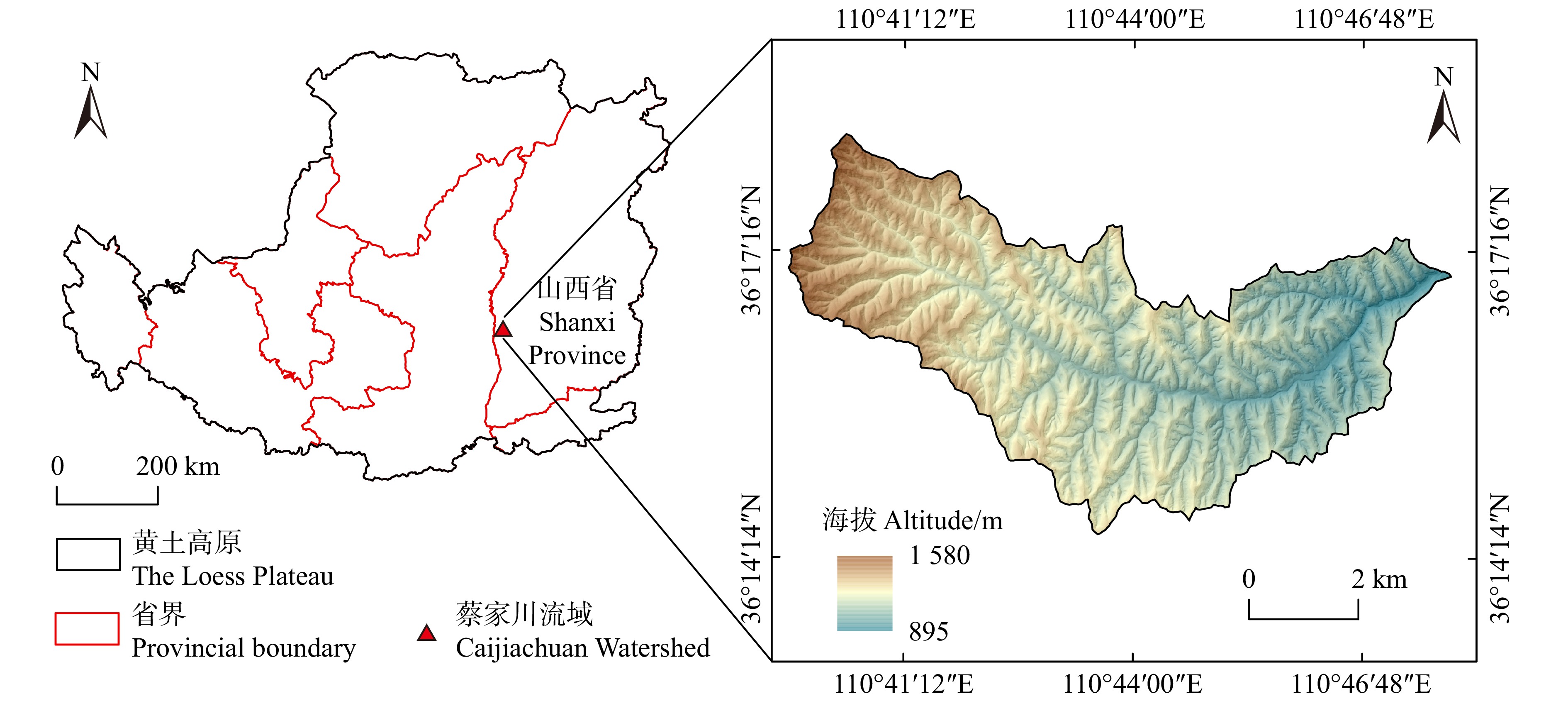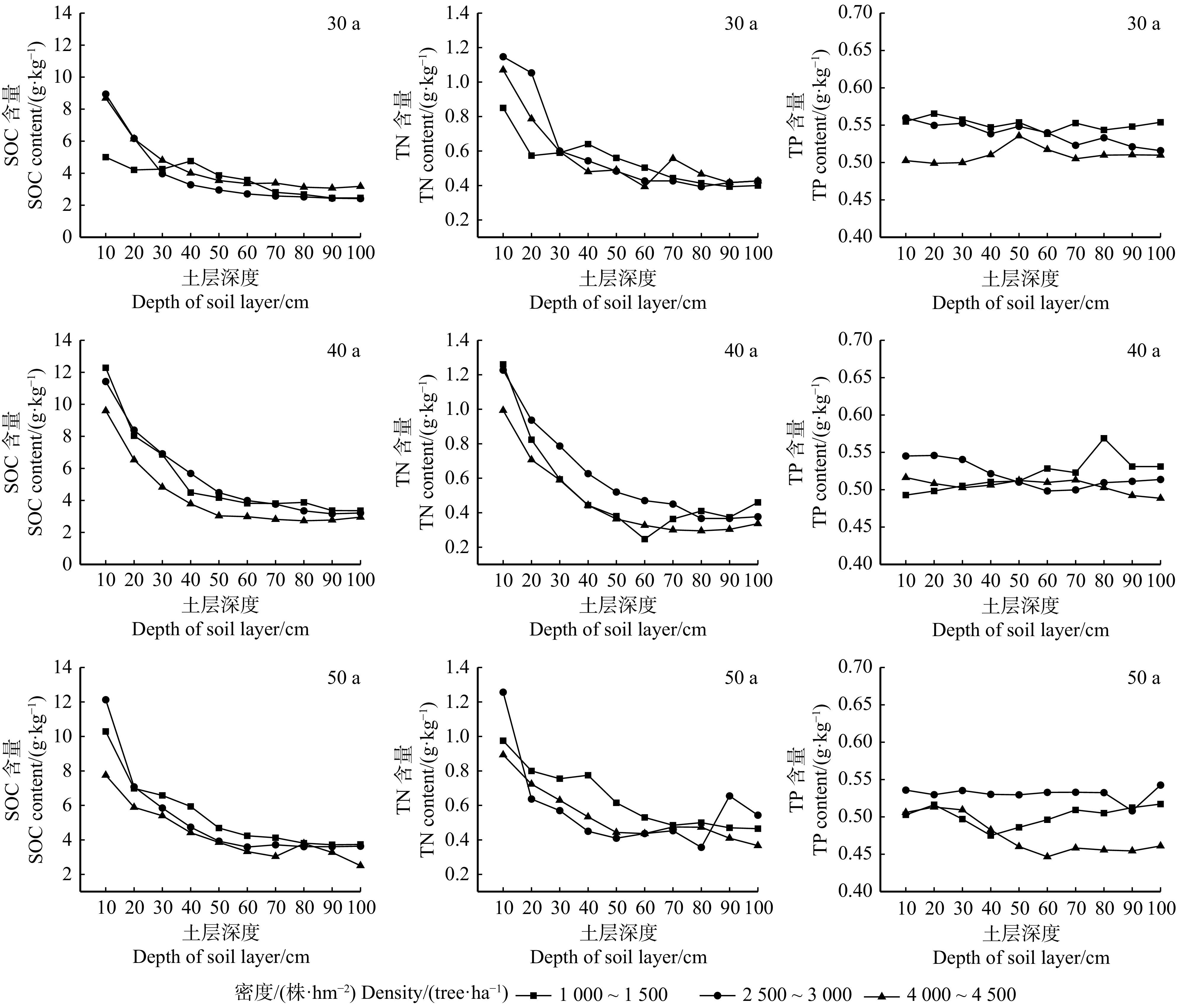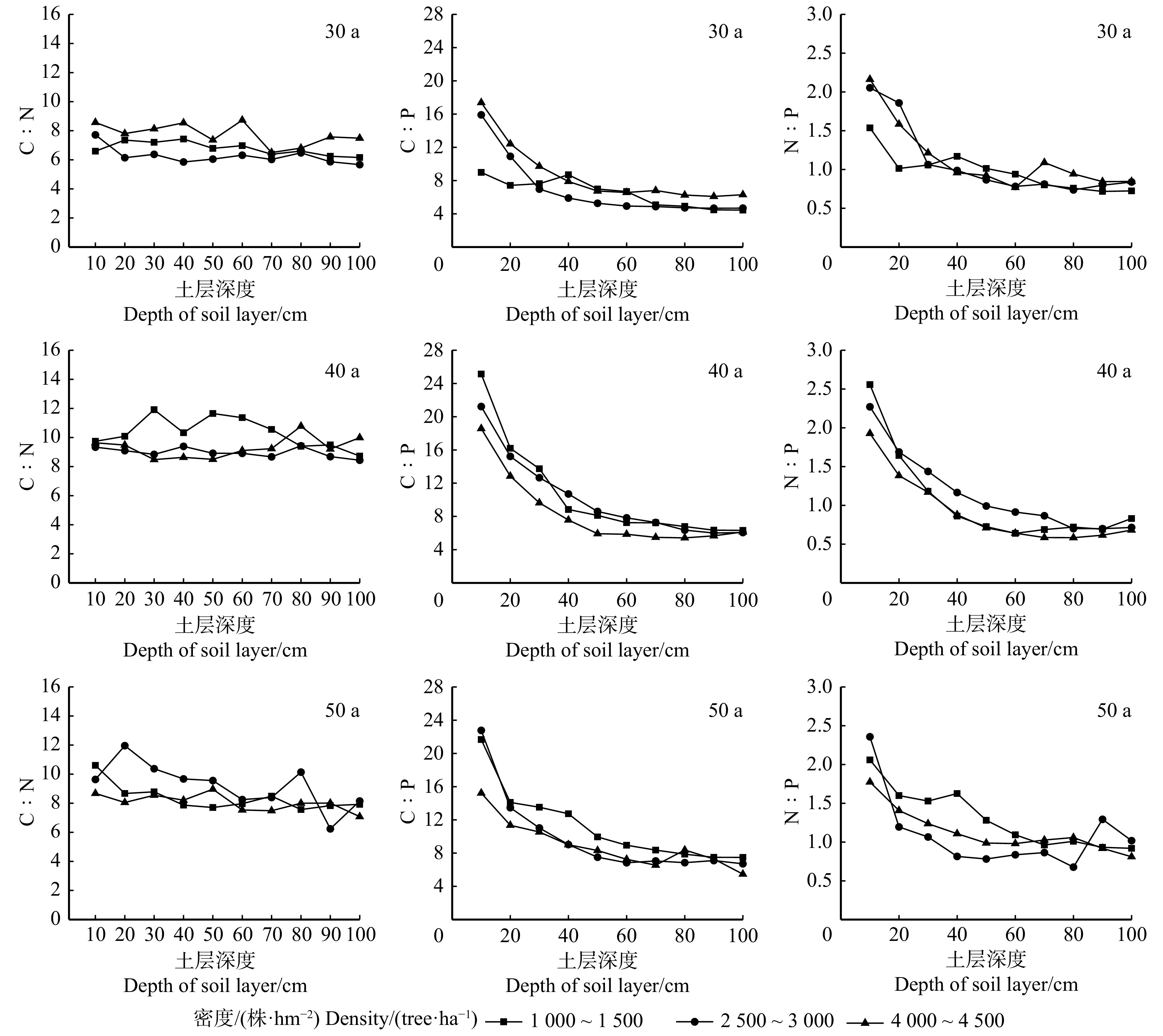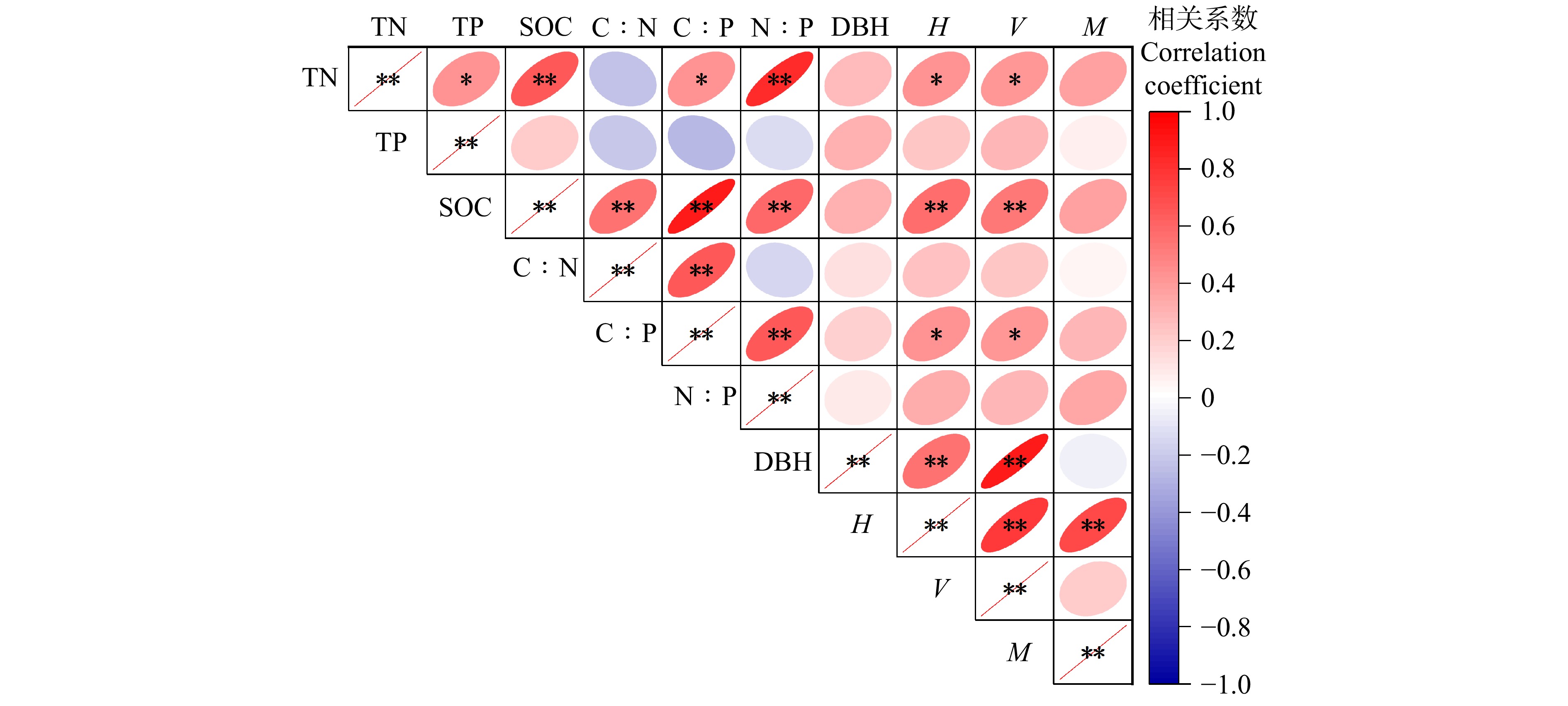Response of soil carbon, nitrogen and phosphorus stoichiometric characteristics of Pinus tabuliformis forests to stand age and density in the Loess Plateau region of western Shanxi Province, northern China
-
摘要:目的
分析油松林土壤碳(C)氮(N)磷(P)计量特征对林龄和密度的响应,旨在探究不同林龄条件下密度对土壤化学计量的影响规律,为油松人工林可持续经营提供科学依据。
方法以晋西黄土区蔡家川流域内3种林龄(30、40、50 a)和3种密度(1 000 ~ 1 500株/hm2、2 500 ~ 3 000株/hm2、4 000 ~ 4 500株/hm2)的油松人工林为研究对象,测定并分析0 ~ 100 cm土壤化学计量特征。
结果(1)林龄和密度的双因素交互作用对土壤有机碳(SOC)、土壤全氮(TN)、C∶N、C∶P、N∶P影响显著(P < 0.05)。(2)林龄对不同密度油松林土壤TN、SOC和化学计量比有不同影响,高密度林分中,在林龄增长至50 a时,表层土壤肥力指标出现明显衰退趋势;林龄较高时,低密度的林分土壤养分较高。(3)土壤TN 与 TP、SOC、C∶P、N∶P 均呈显著正相关(P < 0.05),SOC 与 C∶N、C∶P、N∶P均有极显著正相关关系(P < 0.01),C、N元素对林分生长指标有显著影响(P < 0.05)。
结论在黄土区应根据不同林龄阶段合理调节林分密度,30 a的油松林适宜密度为4 000株/hm2,40 a时密度应调整至2 500 ~ 3 000株/hm2,50 a的油松密度为1 000 ~ 1 500株/hm2时土壤养分最优。适宜的林分密度可以保证林地土壤养分状况维持在最优状态,有利于人工林分现阶段可持续经营以及后续土壤保育功能的持续发挥。
Abstract:ObjectiveAnalyzing the responses of soil carbon (C), nitrogen (N), and phosphorus (P) stoichiometry to stand age and density in Pinus tabuliformis forest land can provide scientific evidence for sustainable management of Pinus tabuliformis plantations.
MethodThis study focused on Pinus tabuliformis plantations of three stand ages (30, 40 and 50 years) and three densities (1 000−1 500 tree/ha, 2 500−3 000 tree/ha, 4 000−4 500 tree/ha) in the Caijiachuan Watershed, western Shanxi Province of northern China. Soil C, N, and P contents and their stoichiometric ratios were measured and analyzed from 0 to 100 cm depth layer.
ResultThe two-factor interaction of stand age and density showed a significant influence on SOC, total N (TN), C∶N, C∶P, and N∶P (P < 0.05). (2) Stand age had different effects on soil TN, SOC, and chemical stoichiometric ratios in stands of different densities, plantations with high density exhibited soil fertility decline at 50 years. Older plantations indicate that lower stand density is associated with higher soil nutrient levels. (3) Soil TN was significantly positively correlated with TP, SOC, C∶P, and N∶P (P < 0.05); SOC was significantly positively correlated with C∶N, C∶P, and N∶P (P < 0.01). C and N elements had a significant impact on soil chemical stoichiometry and stand growth (P < 0.05).
ConclusionIn loess area, it is necessary to rationally adjust stand density according to different Pinus tabuliformis stand ages. For a 30-year-old stand, the recommended density was 4 000 tree/ha. The density should be reduced to 2 500−3 000 tree/ha at 40 years. For a 50-year-old stand, the optimal density range for soil nutrients was 1 000−1 500 tree/ha. The appropriate stand density can ensure that the soil nutrient status of the forest land is maintained at an optimal level, which is beneficial for the current sustainable management of the artificial forest and the continuous function of subsequent soil conservation.
-
在农林业生产中,植物常遭受重金属等各种土壤条件胁迫。铅(Pb)是重金属污染物中影响较严重的元素之一,又是植物非必需元素,其在组织中大量积累会引起植物体内细胞膜脂过氧化,最终影响生长和品质[1-2],因此修复Pb胁迫土壤具有重要意义。作为生态修复的重要内容之一,植物修复已成为近年来国际环境领域研究的热点[3]。在Pb胁迫土壤的植物修复中,特别是在植物生长初期,如何提高植物适应性和存活力尤其引人关注。
作为一种天然螯合剂,土壤中各种来源的有机酸显著影响重金属在土壤中的迁移转化行为及植物有效性,在控制Pb等重金属生物毒性方面发挥重要作用[4-5]。植物对重金属的解毒机制包括外部排斥和内部耐受两类,这两类机制中有机酸均起重要作用[6-7]。外部排斥机制即有机酸与金属离子形成稳定的金属配位体复合物,阻止金属离子进入植物体内或避免其在根部敏感位点累积;内部耐受机制即有机酸可与进入植物体内的金属离子螯合,使其转化为无毒或毒性较小的结合形态[7-8]。在重金属胁迫下,植物一般通过多种机制的联合以防止中毒,但植物种类不同解毒机制也不同[7]。有机酸还显著影响Pb胁迫下植物的多种生理生化特性、生长和生物量分配格局,最终提高Pb胁迫土壤上植物的生态适应性及土壤修复效率[4]。有机酸对上述指标的影响,不仅与植物种类有关,还与有机酸种类和浓度、Pb胁迫程度和处理时间等密切相关[11]。目前,有机酸提高植物适应性的作用已在一些植物上证实,如欧洲油菜(Brassica napus)、马蔺(Iris lactea var. chinensis)等,有机酸种类涉及草酸、柠檬酸和水杨酸等,测定指标涉及电导率、可溶性蛋白含量、Pb吸收和生物量积累等[9-11]。值得指出的是,除上述常规指标外,叶绿素荧光参数、根系形态特性和养分元素吸收也是鉴定植物抗逆性的重要指标,是植物适应土壤环境的基础[12];且F0、Fv/Fm和Fv/F0等荧光指标、比根长等根系形态特征及Fe等养分元素吸收状况对Pb胁迫都非常敏感[13-14]。但目前,外源有机酸影响植物对土壤Pb胁迫的适应性研究仍集中在农业领域,在林业领域相对较少,特别是如何影响Pb胁迫下林木的叶绿素荧光参数、根系形态特性和营养元素吸收运输还鲜见报道。
我国东北林区有一定面积的矿山土急需复垦,如黑龙江省伊春西林铅锌矿等。这些立地条件下,Pb胁迫普遍存在。长白落叶松(Larix olgensis)是东北山区的重要乡土树种,因成活率高和对环境要求不甚严格,就成为Pb胁迫矿山土植被恢复和林业复垦的先锋树种。但在较严重的Pb胁迫下,其成活和生长仍受较大限制,特别是初期“造林不成活”现象普遍存在。通过前人研究可以假设,外源有机酸亦能在苗期提高长白落叶松对Pb胁迫的适应性和抗性。但目前,有机酸如何影响Pb胁迫下长白落叶松幼苗的生态适应性还未见报道。草酸和柠檬酸是我国东北林区森林凋落物淋洗液中存在的2种优势有机酸,数量均较为可观[15]。本文模拟此区长白落叶松凋落物淋洗液中草酸和柠檬酸浓度范围[15],通过外源添加不同浓度草酸或柠檬酸溶液,系统研究了不同处理时间下,有机酸对长白落叶松幼苗多种生理生化特性、Pb及养分元素吸收及生长的影响,特别是首次揭示了有机酸如何影响Pb胁迫下苗木的叶绿素荧光参数、根系形态特征及养分元素吸收状况。研究旨在探讨有机酸对Pb胁迫下苗木生态适应性的调控意义及机制,从而为有机酸应用于Pb矿区废弃地的植被恢复提供生理生态学理论依据,也能为Pb胁迫土壤的有效利用开辟新思路。
1. 材料与方法
1.1 苗木培育与处理
实验在东北林业大学帽儿山实验林场温室内进行。长白落叶松种子选种、消毒、雪藏催芽后,2016年4月末播种于塑料育苗盆(底径16.2 cm、上口径18.4 cm、高20.0 cm),覆土料为质地均一、无杂质的A1层暗棕壤(本区地带性土壤,基本性质见表 1)。土壤采自林场内长白落叶松人工林下,去除根系、土壤动物等,自然风干1 d,装盆,每盆5.5 kg。每盆育苗60株,盆上沿土壤空出2~3 cm以浇水、有机酸和Pb处理。2016年5月末间苗,每盆剩30株(由于当地气候条件限制,苗木生长缓慢,出苗1个月时平均苗高仅4.3 cm,平均地径1.05 cm,这样的密度有利于形成良好的种群优势,而不会产生生长空间的竞争)。
表 1 供试A1层暗棕壤的基本性质Table 1. Selected properties of A1 horizon of dark brown forest soil used in the experiment土壤层次
Soil layerpH值
pH value (H2O)阳离子交换量
Cation exchange capacity/(cmol·kg-1)有机质
Organic matter/ (g·kg-1)全氮
Total N/ (g·kg-1)全磷
Total P/ (g·kg-1)速效磷
Available P/ (mg·kg-1)土壤质地
Soil texture黏粒Clay (<2 μm)/ (g·kg-1) 草酸含量
Oxalic acid concentration/(μg·kg-1)柠檬酸含量
Citric acid concentration/(μg·kg-1)A1 5.32 40.2 107.9 6.39 2.08 45.8 壤质
Loamy texture135 310.98 139.83 注:30 mmol/L NH4F+25 mmol/L HCl浸提法;A1为暗棕壤层。下同。Notes: means extracted with 30 mmol/L NH4F+25 mmol/L HCl; A1 means horizon of dark brown forest soil. The same below. 缓苗1月后,将Pb(NO3)2溶液均匀地添加到土壤中以进行Pb胁迫处理,使土壤内Pb2+含量达100 mg/kg(依前期调查的黑龙江省伊春西林铅锌矿区土壤Pb含量设定)。Pb处理10 d后,采取灌根方式进行外源有机酸添加处理[草酸(OA)或柠檬酸(CA)],使土壤内有机酸浓度分别达0、0.04、0.2、1.0和2.0 mmol/kg。另外,在长白落叶松苗期,由于其根系生长慢且发育不完全[16],还采用类似叶面施肥的方式进行了有机酸喷施[17]。具体讲:将有机酸溶液(浓度分别为0、0.2、1.0、5.0和10.0 mmol/L)均匀地喷施在苗木叶片的上、下表面,以叶面均匀湿润为止。实验处理见表 2。有机酸以有机盐形式添加(pH 5.16,仿当地土壤溶液平均pH值),每天1次,共7 d,均在早晨08:00进行。土壤无Pb胁迫、等量蒸馏水处理为对照(CK)。由于当地气候寒冷,温室育苗最早也得在4月末进行,8月下旬叶片已开始变黄脱落,不能再进行相关指标的准确测定。综合考虑出苗、缓苗、Pb胁迫和有机酸处理等时间,分别在有机酸处理后第10、20、30天采样分析。每处理栽10盆苗,每个处理时间10个重复,3个时间共300盆。
表 2 实验设计(10、20、30 d均进行如下处理)Table 2. Experimental layout (each of the treatments below was sampled after 10, 20, or 30 days)处理Treatment 土壤处理Soil treatment 有机酸类型Kind of organic acid 有机酸浓度Concentration of organic acid/(mmol·L-1) CK A1、无Pb
A1, no Pb― 0 T1 A1+Pb ― 0 T2 A1+Pb OA 0.2 T3 A1+Pb OA 1.0 T4 A1+Pb OA 5.0 T5 A1+Pb OA 10.0 T6 A1+Pb CA 0.2 T7 A1+Pb CA 1.0 T8 A1+Pb CA 5.0 T9 A1+Pb CA 10.0 1.2 样品采集与测定
1.2.1 生理生化指标和元素含量
在各处理10盆苗木中,随机采集中部叶片(约2.0 g),立即、分别用上海雷磁DDS-6700电导仪和考马斯亮蓝G-250染色法测定相对电导率和可溶性蛋白含量。再随机采集苗木中部叶片,把采过叶片的幼苗小心地从土中取出(避免根系损伤),采集 < 2 mm细根。叶片和细根用蒸馏水洗净擦干,105 ℃下杀青15 min,70 ℃下烘至恒质量,粉碎,过2 mm尼龙筛,用微波消解ICP-MS法测定叶片和细根Pb、Mg和Fe含量。每处理重复3次。
每处理选3株幼苗暗处理20 min后,选取完整叶片用LI-6400 XT便携式光合仪(Licor,US)测定叶绿素荧光指标。通过测得的F0(初始荧光)和Fm(最大荧光),计算得到Fv/Fm和Fv/F0,其中Fv=Fm-F0。每处理重复3次。
1.2.2 根系形态特征
在各处理10盆苗木中,每处理随机选3株幼苗,小心地将根系取出,用去离子水洗净,用滤纸小心吸干,用枝剪将根、茎和叶分开,再用根系分析仪(Win-RHI Z0-2004a,Canada)测定根系形态,得到表面积、长度、体积和平均直径,并计算得到比根长(长度/干质量)。
1.2.3 生长
在各处理10盆苗木中,每处理选15株幼苗,小心地从盆中取出,将茎、叶和根分开,用去离子水洗净吸干,105 ℃下杀青15 min,60 ℃下烘至恒质量,得到各部分干质量及平均值。
1.3 数据处理
用SPSS 18.0对数据进行统计分析,采用Duncan新复极差法对所有指标数据进行差异显著性检验(P < 0.05)。
2. 结果与分析
2.1 苗木细胞膜透性变化
与对照(CK)比,Pb胁迫(T1)增加苗木叶片相对电导率,说明叶片细胞膜受损,且时间越长损伤越重。与无有机酸处理(T1)相比,草酸和柠檬酸显著降低Pb胁迫下苗木的相对电导率,2种有机酸均在10.0 mmol/L效果最好,柠檬酸强于草酸,不同时间效果为30 d>10 d>20 d(图 1)。
2.2 可溶性蛋白含量变化
与CK相比,苗木叶片可溶性蛋白含量在Pb胁迫后(T1)降低(时间越长降幅越大),但有机酸处理后显著提高,所有处理均达显著水平,5.0或10.0 mmol/L效果最好,2种有机酸增幅均为10 d>30 d>20 d,柠檬酸作用强于草酸(图 2)。
2.3 叶片叶绿素荧光参数变化
Pb胁迫显著影响叶片叶绿素荧光指标,F0升高,Fm、Fv、Fv/Fm和Fv/F0均降低。有机酸使上述指标均向相反方向变化,变化幅度与其浓度大体呈正相关,一般10.0 mmol/L变幅最大。不同时间内各指标变幅不同:F0为30 d>20 d>10 d,Fm为30 d>10 d>20 d,Fv为30 d>20 d>10 d,Fv/Fm和Fv/F0为30 d>20 d>10 d。除少数0.2 mmol/L处理外,柠檬酸影响均强于草酸(图 3)。
2.4 根系形态特征变化
Pb胁迫显著影响苗木根系形态特征,表面积、长度、体积和比根长降低,时间越长降幅越大,但平均直径增加。有机酸使上述指标向相反方向变化,大都以10.0 mmol/L影响最显著,柠檬酸强于草酸。表面积、长度、体积、比根长和平均直径时间序列分别为30 d>20 d>10 d,30 d>20 d>10 d,30 d>20 d>10 d,10 d>20 d>30 d和10 d>30 d>20 d(图 4)。
2.5 苗木体内Pb和营养元素含量变化
Pb胁迫显著增加细根和叶片Pb含量,且在根部强烈积累。有机酸使细根和叶片Pb含量先降后增,大多在10.0 mmol/L时仍低于有机酸0组(T1)。对于根系Pb积累,草酸影响大多强于柠檬酸,叶片则相反。不同有机酸浓度和处理时间内无明显规律。Pb胁迫增加细根和叶片Fe含量及细根Mg含量,但降低叶片Mg含量。有机酸降低细根和叶片Mg含量,但增加Fe含量,大多在10.0 mmol/L变幅最大。不同时间内细根Mg含量降幅为30 d>20 d>10 d,Fe含量增幅为10 d>20 d>30 d;叶片Mg含量降幅为30 d>20 d>10 d,Fe含量增幅为30 d>10 d>20 d。除极少数处理外,柠檬酸效果强于草酸(图 5)。
2.6 生长变化
与CK相比,Pb胁迫显著降低苗木的根、茎和叶干质量,但有机酸处理后各部分干重量大多显著增加,一般10.0或5.0 mmol/L增加效果最显著,不同时间的增加效果为20 d>30 d>10 d,柠檬酸效果强于同浓度草酸(图 6)。
3. 讨论
3.1 有机酸对Pb胁迫下细胞膜系统的保护作用
Pb胁迫显著增加长白落叶松叶片相对电导率和质膜透性(图 1),可能Pb与细胞膜上的磷脂作用形成正磷酸盐、焦磷酸盐,从而改变膜结构;或者Pb被细胞壁上果胶酸吸附,改变了细胞壁弹性和塑性,损害了壁的生理功能[18]。本结果与玉米(Zea mays)[18]、海榄雌(Avicennia marina)[19]等研究一致。Pb胁迫下,草酸和柠檬酸显著降低长白落叶松相对电导率(图 1),说明有机酸减缓了电解质渗出和细胞膜损伤,能通过提高质膜系统稳定性诱导苗木适应性,此结果与柠檬酸和草酸对马蔺[9]、柠檬酸对灯心草(Juncus effuses)[20]等研究一致。
3.2 有机酸与Pb胁迫下的渗透调节物质
作为渗透调节物质,可溶性蛋白含量能反映植物总体代谢状况及抗逆性[21]。Pb降低长白落叶松叶片可溶性蛋白含量(图 2),说明此时苗木体内代谢改变及蛋白质合成受阻,且时间延长影响增大。Pb胁迫下蜡熟期玉米、镉(Cd)污染下苎麻(Plagiomnium acutum)等研究也如此,且随重金属浓度升高而下降[18, 22]。但也有人认为,Pb等胁迫下,植物除合成蛋白质以络合进入体内的重金属离子、降低其危害外,可溶性蛋白含量上升还能增加细胞渗透浓度和功能蛋白数量,有助于维持细胞正常代谢[23]。
外源有机酸提高长白落叶松可溶性蛋白含量(图 2),说明此时苗木的生理生化反应与代谢活动都显著增强,进而能从渗透调节角度提高苗木对Pb胁迫的适应性。同样,1.5和4 mmol/L柠檬酸也使苎麻叶片和根系可溶性蛋白含量分别增加2.9和6.4 mg/g,但高浓度草酸(9 mmol/L)却使叶片含量降低3.1 mg/g[22]。
3.3 叶绿素荧光对Pb胁迫和有机酸的响应
Pb诱导长白落叶松叶片F0显著上升(图 3),这与Pb、Cd胁迫下银芽柳(Salix leucopithecia)、云南樟(Cinnamomum glanduliferum)等研究一致[24-25],且增加越多损伤越重[26]。但Pb降低黑麦草(Lolium perenne)F0,随其浓度而下降,可能因为Pb降低叶绿素含量,使捕获和传递给PSII反应中心的光能减少、电子传递受阻[27]。Pb还降低长白落叶松Fv/Fm和Fv/F0(图 3),说明Pb离子抑制光合作用原初反应,使其开放程度和捕获激发能效率下降,这可能与其抑制叶绿素合成有关,或由于Pb竞争性抑制放氧复合体中23kd蛋白上Ca2+和Cl-结合位点,从而阻止电子从PSII向PSI传递[28]。本结果与云南樟[25]、尖叶走灯藓(Plagiomnium cuspidatum)[29]、玉米[30]、黑麦草[31]等研究一致。但也有不同报道,如100 μmol/L和0.25 mmol/L Pb分别对柳条莫丝(Fontinalis antipyretica)和玉米Fv/Fm影响均不明显[28, 32]。Pb引起Fv/Fm和Fv/F0变化一般与其浓度显著正相关[28, 33],且有明显的时间效应,时间越长长白落叶松Fv/Fm和Fv/F0降幅越大(图 3),但高浓度Pb使湿地匍灯藓(Plagiomnium acutum)Fv/F0第1天即明显降低,低浓度则先增后降[34]。
有机酸如何影响植物(特别是重金属胁迫下)叶绿素荧光参数目前还鲜见报道。Pb等重金属可能通过影响水裂解端电子流而降低PSII原初光能捕获能力和电子传输能力[35],抑制点主要在光系统II氧化面[36]。Pb还刺激PSII核心蛋白磷酸化,影响PSII复合物稳定性和D1蛋白降解速率[30]。Pb和柠檬酸存在下,田青(Sesbania drummondii)幼苗Fv/Fm和Fv/F0不变,光合效率正常[37];但Pb和草酸或柠檬酸处理下,长白落叶松F0降低,Fv/Fm和Fv/F0升高(图 3),说明有机酸明显抑制Pb引起的PSII光合反应中心损伤,有效缓解反应中心吸收的光能用于电子传递量子产额的降幅,减轻光合电子传递和光抑制,提高了光合活性。上述差异可能与植物类型、Pb处理方式和水平及有机酸浓度等不同有关。
3.4 Pb胁迫、有机酸与植物根系形态、元素吸收和生长
Pb降低长白落叶松根系表面积、长度、体积和比根长(图 4),说明Pb已超过苗木耐受范围,并抑制根系纵向生长,这与高羊茅(Festuca elata)、多年生黑麦草[38]、马蔺[10]及麻疯树(Jatropha curcas)[39]等研究一致。Pb还增加苗木根系平均直径(图 4),即使根系变粗膨大,可能因为Pb影响了根细胞增殖和分化,特别是根尖细胞的分裂分化。Pb对根系毒害明显强于芽等其他器官[40-41],可能因为根最先感受毒害,根细胞壁上还有能大量固定Pb离子的交换位点,根尖吸收Pb后诱发过量的自由基产生,从而伤害根系代谢中的琥珀酸脱氢酶等,降低根系活力,并抑制其向地上部转移[42]。
有机酸明显促进Pb胁迫下长白落叶松生长(图 6),可能原因包括:1)有机酸益于叶绿素荧光、可溶性蛋白等生理特性(图 1~3),这不但能提高光合速率促进有机物积累,还有益于水和无机盐运输。2)有机酸促进根系生长(图 4),这能缓解Pb对根系活力和生理功能的限制,还增加苗木与土壤的接触面积及Fe等养分的吸收利用(图 5),减缓Pb胁迫导致的某些养分吸收利用受抑而引起的干物质积累减少。Pb也破坏菲白竹(Pleioblastus fortunei)体内矿质营养平衡,特别是打破Na+/K+平衡是Pb毒害主要原因[43]。本结果与柠檬酸、草酸等对马蔺影响一致[9]。对长白落叶松生理特性和养分吸收的影响柠檬酸均强于草酸,对生长影响也如此。
外源有机酸能缓解植物的重金属中毒症状,在植物对重金属的外部排斥(即避性机制)和内部耐受等机制中均发挥重要作用[7-8, 44]如柠檬酸和酒石酸分别可减轻Pb、Cd对萝卜(Raphanus sativus)的毒害[45],柠檬酸还促进Pb和Cd从其根系向地上部的转运[46]。本研究发现,较低浓度草酸和柠檬酸处理时,长白落叶松幼苗细根和叶片Pb含量降低,说明此时苗木对Pb胁迫的解毒机制主要体现在外部排斥机制。5.0~10.0 mmol/L较高浓度有机酸处理时,苗木体内Pb含量升高,则此时内部耐受机制发挥的作用更大,但也不排除2种机制同时起作用的可能性。
4. 结论
1) 长白落叶松幼苗对Pb胁迫响应明显,叶片细胞膜透性和F0提高,叶片可溶性蛋白含量、Fm、Fv、Fv/Fm和Fv/F0,根系表面积、长度、体积和比根长都降低,细根和叶片Pb含量显著增加,叶片Mg含量及根、茎和叶干质量降低,且时间越长影响越大。
2) 外源草酸和柠檬酸使上述生理生化和根系形态指标均向相反方向变化,显著增加苗木各部分干质量,因此外源有机酸对提高长白落叶松对Pb胁迫土壤的生态适应性有积极意义。
3) 较低浓度草酸和柠檬酸对苗木解毒Pb胁迫的机制主要体现在外部排斥机制,5.0~10.0 mmol/L较高浓度处理时则内部耐受机制作用更大,但也不排除2种机制同时起作用的可能性。
4) 外源有机酸对苗木生态适应性的影响,一般在20或30 d、5.0或10.0 mmol/L效果最好,且柠檬酸强于草酸。
-
图 2 不同林龄和密度油松林0 ~ 100 cm土壤养分含量
不同大写字母表示相同林龄,不同密度之间差异显著(P < 0.05);不同小写字母表示相同密度,不同林龄之间差异显著(P < 0.05)。下同。Different capital letters indicate significant differences (P < 0.05) between varied densities of the same stand age, and different lowercase letters indicate significant differences (P < 0.05) between varied stand ages of the same density. Same as below.
Figure 2. Nutrient contents of 0−100 cm soil of different stand ages and densities of Pinus tabuliformis plantation
表 1 样地基本情况
Table 1 Basic information of sample plots
林分类型
Stand type林龄/a
Stand
age/year林分密度/(株·hm−2)
Stand density/
(tree·ha−1)坡度
Slope/(°)海拔
Altitude/m平均胸径
Average
DBH/cm平均树高
Average tree
height/m单木材积
Single tree
volume/m3林分蓄积量/(m3·hm−2)
Stand volume/
(m3·ha−1)YD 30 1 125 34 1 189 14.55 8.33 0.24 271.72 1 025 28 1 139 14.13 7.52 0.19 203.53 1 250 30 1 158 14.04 8.22 0.22 279.98 YZ 2 650 30 1 075 10.98 8.67 0.15 410.43 2 875 27 1 171 12.86 9.79 0.23 674.33 2 800 30 1 196 11.82 7.85 0.14 417.56 YG 4 475 36 1 252 10.67 10.12 0.18 846.17 4 000 29 1 290 10.92 9.19 0.16 671.92 4 100 20 1 357 9.48 8.15 0.11 467.55 ZD 40 1 266 38 1 350 13.65 8.87 0.22 280.74 1 175 36 1 403 14.37 9.47 0.28 337.77 1 475 28 1 367 15.30 11.15 0.40 600.23 ZZ 2 875 34 1 340 9.03 6.44 0.07 213.89 2 900 26 1 358 12.70 10.28 0.24 719.19 2 788 22 1 370 11.90 10.13 0.22 615.55 ZG 4 200 22 1 279 10.60 8.27 0.13 575.26 4 500 24 1 339 10.11 7.03 0.10 451.04 4 425 30 1 366 8.84 6.76 0.07 342.94 LD 50 1 200 21 1 372 14.66 8.01 0.23 276.94 1 375 25 1 385 14.21 10.11 0.31 430.48 1 500 25 1 390 14.63 10.36 0.33 509.22 LZ 2 975 30 1 336 11.87 10.16 0.22 657.48 3 000 21 1 333 10.94 7.37 0.12 362.91 2 600 25 1 354 13.27 9.72 0.24 631.99 LG 4 000 31 1 199 9.84 6.12 0.07 314.71 4 025 21 1 307 11.02 10.47 0.20 840.07 4 088 20 1 344 11.37 8.98 0.17 702.65 注:林分类型中字母Y、Z、L分别代表30、40、50 a 3种林龄;字母D、Z、G分别代表低(1 000 ~ 1 500株/hm2)、中(2 500 ~ 3 000株/hm2)、高(4 000 ~ 4 500株/hm2)3种密度。Notes: letters Y, Z, and L in stand type represent 30, 40, and 50 years, respectively; and the letters D, Z, and G represent low (1 000−1 500 tree/ha), medium (2 500−3 000 tree/ha), and high (4 000−4 500 tree/ha) densities, respectively. 表 2 油松人工林地土壤 C、N、P含量及化学计量比的多因素方差分析
Table 2 Multi-way ANOVA of soil C, N and P contents and stoichiometric ratios of Pinus tabuliformis plantation
因素
Factor土壤有机碳含量
Soil organic
carbon (SOC) content全氮含量
Total nitrogen
(TN) content全磷含量
Total phosphorus
(TP) content土壤碳氮比
Soil C∶N土壤碳磷比
Soil C∶P土壤氮磷比
Soil N∶P林龄 Stand age 20.32** 1.32* 1.28 42.95** 29.01** 3.83* 密度 Density 4.67* 3.27* 0.97 5.64** 3.32* 3.70* 土层深度 Depth of soil layer 65.63** 35.99** 0.27 1.28 62.48** 39.80** 林龄 × 密度 Stand age × density 6.01** 1.98* 1.22 5.45** 7.32** 3.55** 林龄 × 土层深度 Stand age × depth of soil layer 1.59 0.72 0.34 0.37 1.86 0.94 密度 × 土层深度 Density × depth of soil layer 0.83 0.61 0.36 0.35 0.56 0.55 林龄 × 密度 × 土层深度
Stand age × density × depth of soil layer0.79 0.78 0.34 0.52 1.07 0.98 注:*、**分别代表在P < 0.05、P < 0.01水平上显著相关。下同。表中数字为F值。Notes:* and ** represent significant correlations at level of P < 0.05 and P < 0.01, respectively. Same as below. The numbers in the table are F values. -
[1] 胡亚伟, 施政乐, 刘畅, 等. 晋西黄土区刺槐林密度对林下植物多样性及土壤理化性质的影响[J]. 生态学杂志, 2023, 42(9): 2072−2080. Hu Y W, Shi Z L, Liu C, et al. Effects of stand densities on understory vegetation diversity and soil physicochemical properties of Robinia pseudoacacia forest in loess region of western Shanxi Province[J]. Chinese Journal of Ecology, 2023, 42(9): 2072−2080.
[2] 赵蔓, 张晓曼, 杨明洁. 林火干扰对栓皮栎–辽东栎混交林植物多样性与土壤理化性质的影响[J]. 生态环境学报, 2023, 32(10): 1732−1740. Zhao M, Zhang X M, Yang M J. Effects of forest fire disturbance on species diversity and soil physicochemical properties of Quercus variabilis and Quercus wutaishansea mixed forests[J]. Ecology and Environmental Sciences, 2023, 32(10): 1732−1740.
[3] 王绍强, 于贵瑞. 生态系统碳氮磷元素的生态化学计量学特征[J]. 生态学报, 2008, 28(8): 3937−3947. doi: 10.3321/j.issn:1000-0933.2008.08.054 Wang S Q, Yu G R. Ecological stoichiometry characteristics of ecosystem carbon, nitrogen and phosphorus elements[J]. Acta Ecologica Sinica, 2008, 28(8): 3937−3947. doi: 10.3321/j.issn:1000-0933.2008.08.054
[4] Chen Q, Shi Z, Chen S, et al. Role of environment variables in spatial distribution of soil C, N, P ecological stoichiometry in the typical black soil region of Northeast China[J/OL]. Sustainability, 2022, 14(5): 2636[2022−02−24]. https://doi.org/10.3390/su14052636.
[5] 白丽丽, 王文颖, 德却拉姆, 等. 祁连山典型植被土壤碳、氮、磷含量及生态化学计量特征的垂直变化[J]. 干旱区研究, 2024, 41(3): 444−455. Bai L L, Wang W Y, Dequelamu, et al. Elevational variations in ecological soil C, N, and P stoichiometry among five typical vegetation types in the Qilian Mountains[J]. Arid Zone Research, 2024, 41(3): 444−455.
[6] Sun R X, Ma L, Zhang S H, et al. Study on landscape patches influencing hillslope erosion processes and flow hydrodynamics in the Loess Plateau of western Shanxi Province, China[J/OL]. Water, 2020, 12(11): 3201[2024−11−16]. https://doi.org/10.3390/w12113201.
[7] Li H, Wu Y, Liu S, et al. The Grain-for-Green Project offsets warming-induced soil organic carbon loss and increases soil carbon stock in Chinese Loess Plateau[J/OL]. The Science of the total environment, 2022, 837: 155469[2022−09−01]. https://doi.org/10.1016/j.scitotenv.2022.155469.
[8] 何如梦, 王百田, 于显威, 等. 晋西黄土区油松林的生长释放与生长抑制[J]. 应用与环境生物学报, 2018, 24(6): 1204−1210. He R M, Wang B T, Yu X W, et al. Growth release and growth inhibition of Pinus tabulaeformis forest in the Loess Plateau of western Shanxi Province, China[J]. Chinese Journal of Applied and Environmental Biology, 2018, 24(6): 1204−1210.
[9] Li Y C, Li H P, Zhang W, et al. The effects of thinning on tree growth and stand biomass in a chrono sequence of Pinus tabulaeformis plantations in the Loess Plateau of China[J/OL]. Forests, 2023, 14: 1620[2023−08−11]. https://doi.org/10.3390/f14081620.
[10] 胡尔查, 王铮, 李梓豪, 等. 毛乌素沙地不同林龄樟子松人工林林下植物多样性和生物量的动态变化[J/OL]. 生态学杂志, 2024: 1−10[2024−08−02]. http://kns.cnki.net/kcms/detail/21.1148.Q.20240205.1812.010.html. Hu E C, Wang Z, Li Z H, et al. Dynamic changes of understory plant diversity and biomass of Pinus sylvestris var. mongolica plantations at different ages in Mu Us Sandy Land[J/OL]. Chinese Journal of Ecology, 2024: 1−10[2024−08−02]. http://kns.cnki.net/kcms/detail/21.1148.Q.20240205.1812.010.html.
[11] 赵丹阳, 毕华兴, 侯贵荣, 等. 不同林龄刺槐林植被与土壤养分变化特征[J]. 中国水土保持科学(中英文), 2021, 19(3): 56−63. Zhao D Y, Bi H X, Hou G R, et al. Evolution of vegetation and soil nutrients of artificial Robinia pseudoacacia forest[J]. Science of Soil and Water Conservation, 2021, 19(3): 56−63.
[12] Li Q C, Liu Z L, Jin G Z. Impacts of stand density on tree crown structure and biomass: a global meta-analysis[J/OL]. Agricultural and Forest Meteorology, 2022, 326: 109181[2022−11−15]. https://doi.org/10.1016/j.agrformet.2022.109181.
[13] 刘超华, 李凤巧, 廖杨文科, 等. 人工林对土壤地力的影响过程及其调控研究进展[J]. 土壤学报, 2023, 60(3): 644−656. Liu C H, Li F Q, Liao-Yang W K, et al. Research progress on effects and regulation of plantation on soil fertility[J]. Acta Pedologica Sinica, 2023, 60(3): 644−656.
[14] 王宏生, 王玉琴, 宋梅玲, 等. 黄帚橐吾不同密度斑块植物、土壤和微生物碳氮磷生态化学计量特征[J]. 生态学报, 2024, 44(10): 4297−4307. Wang H S, Wang Y Q, Song M L, et al. Carbon, nitrogen and phosphorus stoichiometric characteristics of plants, soils and microbial biomass in patches with different densities of Ligularia virgaurea[J]. Acta Ecologica Sinica, 2024, 44(10): 4297−4307.
[15] Mehrdad Z, Gaëlle V, Nathalie K, et al. The impact of stand composition and tree density on topsoil characteristics and soil microbial activities[J/OL]. Catena, 2024, 234: 107541[2023−09−25]. https://doi.org/10.1016/j.catena.2023.107541.
[16] 卫朝阳, 张建军, 赖宗锐, 等. 晋西黄土区油松人工林密度和立地对细根特征的影响[J]. 北京林业大学学报, 2024, 46(10): 22−32. doi: 10.12171/j.1000-1522.20230282 Wei Z Y, Zhang J J, Lai Z R, et al. Influence of density and site on fine root characteristics of Pinus tabuliformis plantations in loess area of western Shanxi Province, northern China[J]. Journal of Beijing Forestry University, 2024, 46(10): 22−32. doi: 10.12171/j.1000-1522.20230282
[17] 王玉芬. 林分密度在营林生产中的应用[J]. 林业勘查设计, 2011(1): 59−63. Wang Y F. The applications of forest density in forest management[J]. Forest Investigation Design, 2011(1): 59−63.
[18] Zhao M, Liu S H, Sun Y R, et al. Does stand density affect understory vegetation and soil properties of differently aged Robinia pseudoacacia plantations? [J/OL]. Forest Ecology and Management, 2023, 548: 121444[2023−11−15]. https://doi.org/10.1016/j.foreco.2023.121444.
[19] 朱金兆. 晋西黄土残塬沟壑区立地条件类型划分的研究[J]. 北京林学院学报, 1985, 6(4): 25−37. Zhu J Z. A study on the classification of land condition types in the Loess Plateau gully area of western Shanxi Province[J]. Journal of Beijing Forestry College, 1985, 6(4): 25−37.
[20] 成琳, 郭巧生, 朱再标, 等. “根际土–沙氏鹿茸草–寄主植物”连续体碳氮磷生态化学计量特征及耦合关系研究[J]. 生态学报, 2024, 44(18): 8326−8337. Cheng L, Guo Q S, Zhu Z B, et al. Ecological stoichiometric characteristics and the coupling relationship of carbon, nitrogen, and phosphorus in rhizosphere soil-Monochasma savatieri-the host continuum[J]. Acta Ecologica Sinica, 2024, 44(18): 8326−8337.
[21] Zhao W, Huang L M. Changes in soil nutrients and stoichiometric ratios reveal increasing phosphorus deficiency along a tropical soil chrono sequence[J/OL]. Catena, 2023, 222: 106893[2022−12−31]. https://doi.org/10.1016/j.catena.2022.106893.
[22] 巩大鹏, 毕华兴, 王劲峰, 等. 晋西黄土区不同密度刺槐人工林叶片–枯落物–土壤化学计量特征[J]. 林业科学研究, 2024, 37(2): 156−164. Gong D P, Bi H X, Wang J F, et al. Stoichiometric characteristics of leaves-litter-soil of Robinia pseudoacacia of different densities in the loess region of western Shanxi Province[J]. Forest Research, 2024, 37(2): 156−164.
[23] 朱燕, 翟博超, 孙美美, 等. 黄土丘陵区不同密度刺槐和油松人工林土壤理化性质与化学计量特征[J]. 水土保持研究, 2023, 30(6): 160−167. Zhu Y, Zhai B C, Sun M M, et al. Soil physicochemical properties and stoichiometry characteristics in Robinia pseudoacacia and Pinus tabuliformis plantations across different densities in the loess hilly region[J]. Research of Soil and Water Conservation, 2023, 30(6): 160−167.
[24] 加沙来提·阿塔吾拉, 鲁艳, 张波, 等. 塔里木盆地南缘绿洲–沙漠过渡带8种植物C、N、P生态化学计量特征的季节变化[J]. 生态学报, 2024, 44(19): 8605−8616. Jiashalaiti A, Lu Y, Zhang B, et al. Seasonal variation of C, N, and P ecological stoichiometric characteristics of 8 plant species in the oasis-desert transitional zone on the southern margin of the Tarim Basin[J]. Acta Ecologica Sinica, 2024, 44(19): 8605−8616.
[25] 李雪, 王静, 张静, 等. 林龄和林分密度对华北落叶松人工林土壤养分和细菌群落的影响[J]. 中南林业科技大学学报, 2022, 42(10): 83−92. Li X, Wang J, Zhang J, et al. Effects of stand age and stand density on the soil nutrient and bacterial community of Larix principis-rupprechtii plantation[J]. Journal of Central South University of Forestry & Technology, 2022, 42(10): 83−92.
[26] 席丽, 李思瑶, 夏晓莹, 等. 海拔、林龄和郁闭度对天山云杉林土壤肥力的影响[J]. 生态学杂志, 2023, 42(10): 2477−2485. Xi L, Li S Y, Xia X Y, et al. Effects of altitude, stand age, and canopy density on soil fertility in Picea schrenkiana forest[J]. Chinese Journal of Ecology, 2023, 42(10): 2477−2485.
[27] 尹明宇, 吴波, 乌云塔娜, 等. 初植密度对科尔沁沙地樟子松人工林生长和健康状况及土壤化学性质的影响[J]. 西北农林科技大学学报(自然科学版), 2024, 52(7): 42−52. Yin M Y, Wu B, Wuyun T N, et al. Effects of initial planting density on growth, health status and soil chemical properties of Pinus sylvestris var. mongolica plantations in Horqin Sandy Land[J]. Journal of Northwest A&F University, 2024, 52(7): 42−52.
[28] Chen Y, Li Y, Duan Y, et al. Patterns and driving factors of soil ecological stoichiometry in typical ecologically fragile areas of China[J/OL]. Catena, 2022, 219: 106628[2024−09−15]. https://doi.org/10.1016/j.catena.2022.106628.
[29] 武燕, 黄青, 刘讯, 等. 西南喀斯特地区马尾松人工林林龄对土壤理化性质的影响[J]. 南京林业大学学报(自然科学版), 2024, 48(3): 99−107. Wu Y, Huang Q, Liu X, et al. Effects of Pinus massoniana plantation age on soil physical and chemical properties in southwest karst area[J]. Journal of Nanjing Forestry University (Natural Sciences Edition), 2024, 48(3): 99−107.
[30] 芦东旭, 耿雪琪, 崔子怡, 等. 黄土丘陵区不同林龄刺槐养分利用特征和林分质量研究[J]. 北京林业大学学报, 2023, 45(12): 90−99. doi: 10.12171/j.1000-1522.20230058 Lu D X, Geng X Q, Cui Z Y, et al. Nutrient utilization characteristics and stand quality of Robinia pseudoacacia at different stand ages in the loess hilly region of northwestern China[J]. Journal of Beijing Forestry University, 2023, 45(12): 90−99. doi: 10.12171/j.1000-1522.20230058
[31] 刘少华, 赵敏, 王亚娟, 等. 黄土丘陵区林分密度对人工刺槐林土壤理化性质及酶活性影响[J]. 水土保持研究, 2024, 31(5): 123−129, 138. Liu S H, Zhao M, Wang Y J, et al. Effects of stand density on soil physicochemical properties and enzyme activities in Robinia pseudoacacia plantations in the loess hilly-gully region[J]. Research of Soil and Water Conservation, 2024, 31(5): 123−129, 138.
[32] 张晓曦, 胡嘉伟, 刘凯旋, 等. 黄土丘陵区刺槐人工林林龄增加过程中土壤微环境变化对凋落物分解的影响[J]. 生态学报, 2024, 44(7): 2931−2945. Zhang X X, Hu J W, Liu K X, et al. Effects of the alterations in soil micro-environment with increasing stand age of Robinia pseudocacia plantation on the litter decomposition in the loess hilly region[J]. Acta Ecologica Sinica, 2024, 44(7): 2931−2945.
[33] 马雅莉, 高荣, 刘喜东, 等. 白于山区不同植物群落土壤碳氮磷空间分布及化学计量特征[J]. 中南林业科技大学学报, 2023, 43(9): 116−125. Ma Y L, Gao R, Liu X D, et al. Spatial distribution and stoichiometric characteristics of soil carbon, nitrogen and phosphorus in different plant communities in Baiyu Mountain areas[J]. Journal of Central South University of Forestry & Technology, 2023, 43(9): 116−125.
[34] 胡亚伟, 孙若修, 申明爽, 等. 晋西黄土区土地利用方式对土壤C∶N∶P化学计量特征及土壤理化性质的影响[J]. 干旱区研究, 2021, 38(4): 990−999. Hu Y W, Sun R X, Shen M S, et al. Effects of land use types on the stoichiometric characteristics of soil C∶N∶P and the physical and chemical properties of soil in western Shanxi loess region[J]. Chinese Journal of Ecology, 2021, 38(4): 990−999.
[35] 詹紫馨, 冯天骄, 梅柏寒, 等. 晋西黄土区典型植被恢复生态系统各层次化学计量与生态因子的关系[J]. 浙江农林大学学报, 2024, 41(4): 797−809. doi: 10.11833/j.issn.2095-0756.20230448 Zhan Z X, Feng T J, Mei B H, et al. Relationship between stoichiometry and ecological factors at various levels of typical vegetation restoration ecosystem in the loess area of western Shanxi Province[J]. Journal of Zhejiang A & F University, 2024, 41(4): 797−809. doi: 10.11833/j.issn.2095-0756.20230448
[36] Ma Y H, Chen H, Liu D, et al. Identification and management of priority regulation areas based on the supply-demand relationship of ecosystem services: a case study of the Loess Plateau[J]. Ecological Indicators, 2024, 159: 111754[2024−02−15]. https://doi.org/10.1016/j.ecolind.2024.111754.
[37] Liu T R, Peng D L, Tan Z J, et al. Do stand density and month regulate soil enzymes and the stoichiometry of differently aged Larix principis-rupprechtii plantations? [J/OL]. Catena, 2023, 220: 106683[2024−10−21]. https://doi.org/10.1016/j.catena.2022.106683.
[38] 罗也, 王君, 杨雨春, 等. 东北胡桃楸次生林生长随林龄和林分密度的变化规律[J]. 北京林业大学学报, 2024, 46(6): 10−19. doi: 10.12171/j.1000-1522.20230171 Luo Y, Wang J, Yang Y C, et al. Growth patterns of Juglans mandshurica secondary forest with stand age and stand density in Northeast China[J]. Journal of Beijing Forestry University, 2024, 46(6): 10−19. doi: 10.12171/j.1000-1522.20230171
[39] 张煜林, 刘玲娟, 刘胜龙, 等. 不同密度杉木萌生林自然恢复初期群落结构对生态系统碳密度的影响[J]. 应用生态学报, 2024, 35(2): 289−297. Zhang Y L, Liu L J, Liu S L, et al. Effects of community structure of Cunninghamia lanceolata sprouting forests with different densities on ecosystem carbon density at the early stage of succession[J]. Chinese Journal of Applied Eeology, 2024, 35(2): 289−297.
[40] Chen B M, Liu S S, Yu J H, et al. Stand biomass of Pinus sylvestris var. mongolica plantations benefits from high density monocultures in the boreal zone[J/OL]. Forest Ecosystems, 2024, 11: 100222[2024−07−08]. https://doi.org/10.1016/j.fecs.2024.100222.
[41] 罗也, 何怀江, 张忠辉, 等. 张广才岭不同林分密度下物种组成及其多样性[J]. 中南林业科技大学学报, 2023, 43(11): 131−141. Luo Y, He H J, Zhang Z H, et al. Species composition and diversity under different stand densities in Zhangguangcailing[J]. Journal of Central South University of Forestry & Technology, 2023, 43(11): 131−141.
[42] 何普林, 徐其贤, 王忠林, 等. 林龄和土层对柠檬桉林土壤养分和易氧化有机碳的影响[J]. 林业科学研究, 2024, 37(2): 115−123. He P L, Xu Q X, Wang Z L, et al. Effects of stand age and soil layer on soil nutrients and readily oxidizable organic carbon concentrations of Eucalyptus citriodora plantations[J]. Forest Research, 2024, 37(2): 115−123.
[43] 杨桂娟, 胡海帆, 孙洪刚, 等. 林分年龄、造林密度和林分自然稀疏对杉木人工林个体大小分化和生产力关系的影响[J]. 林业科学, 2019, 55(11): 126−136. doi: 10.11707/j.1001-7488.20191114 Yang G J, Hu H F, Sun H G, et al. The influences of stand age, planting density and self-thinning on relationship between size inequality and periodic annual increment in Chinese fir (Cunninghamia lanceolata) plantations[J]. Scientia Silvae Sinicae, 2019, 55(11): 126−136. doi: 10.11707/j.1001-7488.20191114
-
期刊类型引用(1)
1. 徐婷婷,余秋平,漆培艺,刘可慧,李艺,蒋永荣,于方明. 不同淋洗剂对矿区土壤重金属解吸的影响. 广西师范大学学报(自然科学版). 2019(02): 188-193 .  百度学术
百度学术
其他类型引用(1)



 下载:
下载:












